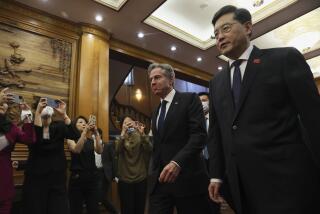Medical Crticle on Crucifixion Stirs Debate
The American Jewish Committee and a Roman Catholic scholar involved in interfaith relations have denounced a Journal of American Medicine article on the crucifixion of Jesus as unsophisticated and perpetuating anti-Semitic stereotypes.
“You have dealt a body blow to years of painstaking Jewish-Christian dialogue and reconciliation,” wrote American Jewish Committee officials.
In a separate letter, discrepancies in the Gospel accounts and the mainstream scholarly uncertainties about what actually happened were pointed out by Eugene J. Fisher, executive secretary of the Secretariat for Catholic-Jewish Relations of the National Conference of Catholic Bishops.
The article published just before Easter sought to analyze the cause of death based upon the New Testament gospel accounts, the Shroud of Turin (believed by some to be Jesus’ imprinted burial cloth) and reputed crucifixion practices of the Romans.
The journal editors earlier said that in the first few weeks after the March 21 publication, 70% of 100 letters received criticized the article or its publication for conveying a fundamentalist bias, for using the Gospels uncritically and for reviving the ancient charge that Jews killed God.
Dr. George Lundberg, editor of the journal, said the response was the greatest to any article during his five-year tenure.
Two of the article’s authors, William Edwards, a pathologist at the Mayo Clinic in Rochester, Minn., and the Rev. Wesley Gabel, a pastor of two United Methodist churches in Minnesota, defended their use of the Gospels as “a reliable historical account of Jesus’ death.”
Their letter published in the journal also said: “We would mourn the day that anyone would use our study to promote anti-Semitism, and we pray that the emergence of this topic may never result in anti-Semitic words or actions.”
The American Jewish Committee letter, whose signers included President Theodore Ellenoff, said: “You accept, without suitable scholarly interpretation, the old, invidious assertions that the Jews as a people agitated for the death of Jesus and that Pontius Pilate--whom history knows to have been a bloodthirsty tyrant--meekly capitulated to their demand. Serious scholars have long ago laid these untruths to rest.”
The Jewish organization said the article was “innocent of critical method” and followed the lead of “fundamentalist writers who eschew scientific methods of textual analysis.”
The journal article cited three conservative authors, including Josh McDowell of Campus Crusade for Christ, for their statement, “Using the legal-historical method of scientific investigation, scholars have established the reliability and accuracy of the ancient manuscripts.”
In one instance, the article’s authors cited some verses from Luke (22:43-44) that are not present in the oldest and best manuscripts of the Gospel, thus indicating to mmost scholars that it was a later scribal addition. The passages said that prior to Jesus’ arrest, he suffered anguish and “his sweat became like great drops of blood.” The authors said this might have been identical to a rare affliction and have and contributed to his condition during the Crucifixion.
Jesus’ weakened condition was also surmised by the authors from the account in Mark, Matthew and Luke that a bystander, one Simon of Cyrene, carried Jesus’ crossbar to the Crucifixion site. Not mentioned was that the Gospel of John says the opposite: Jesus bore his own cross (19:17).
Mainstream biblical scholarship typically notes how the scenes in Mark’s 14th and 15th chapters, which served as narrative models for Matthew and Luke, were probably inspired by passages found in the Old Testament.
“The details of the Crucifixion story are supplied by the Old Testament Scripture (mostly Psalm 22, Isaiah 53) more than from firsthand testimony,” according to “The Interpreter’s One-Volume Commentary on the Bible.” “Nothing is known beyond the simple fact that he was crucified. Neither the location nor the circumstances can be recovered.”
A Los Angeles-area organization of religious publicists has revived after an absence of more than a dozen years.
The Southern California chapter has received its new charter from the Religious Public Relations Council, according to chapter coordinator Peg Parker, editor of the United Methodist newspaper for the Pasadena-based California-Pacific Conference.
The interfaith group, which has started with 15 charter members, acts as an information network for professionals in communications or public relations for religious organizations.
Parker said the chapter may plan some training programs for local church publicists.
A Lutheran-sponsored evangelistic festival at Los Angeles Sports Arena--once scheduled for this spring, then postponed for the lack of organizing time--has been set for May 15-17, 1987.
Bringing Christ to the Nations Festival is sponsored by the International Lutheran Laymen’s League, which is affiliated with the Lutheran Church-Missouri Synod. A North Hollywood office has been established to raise funds for the festival’s $386,000 budget, a spokesman said.
Sister Maura Feeley will become the first woman chancellor of the San Bernardino Roman Catholic diocese when she assumes that position July 1.
Feeley, a Sister of Mercy, has been the vicar for nuns for seven years in the two-county diocese (San Bernardino and Riverside counties) and will continue in that post for another two years. At least three other California dioceses have women in the chancellor role, traditionally filled by monsignor-rank priests.
The revised Code of Canon Law, issued by the Vatican in 1983, removed many of the administrative duties of the chancellor and limited it to witnessing or notarizing official church documents and overseeing the church archives.
But Bishop Phillip F. Straling said Feeley will also serve on his Administrative Council. “We are enhancing the job of chancellor by adding a consultative-advisory role,” he said.
The Rev. John MacArthur, the self-described “pastor-teacher” of about 10,000 worshipers each Sunday at Grace Community Church in Sun Valley, is expanding his educational reach again in September.
MacArthur, a national figure in fundamentalist circles, became president a year ago of The Master’s College in Newhall, previously known as Los Angeles Baptist College. The liberal arts Christian college, in the changeover, ended the relationship with its sponsoring body, the General Assn. of Regular Baptist Churches.
Recently, it was announced that The Master’s College will open a three-year theological seminary on the church grounds, replacing the decade-long extension program there of Talbot Theological Seminary of La Mirada.
“The time is right for a seminary that majors in personal holiness, biblical theology and exegetical preaching, and that trains students right in the context of a vital, local church,” MacArthur said in a statement.
More to Read
Start your day right
Sign up for Essential California for news, features and recommendations from the L.A. Times and beyond in your inbox six days a week.
You may occasionally receive promotional content from the Los Angeles Times.






